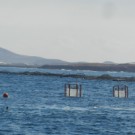Last sampling … It’s an old tradition in German oceanographic research that the last sampler brings up a very special sample. Well, in the case of KOSMOS-GC2 it was Tequilla Sunrise. Actually, it was rum instead of tequilla and the sunrise was kind of upside down. But Paul prepared an excellent mix and we […]
The visitors | Die Besucher
[deutsche Version unten] I am the lucky person within the mesocosm team, with the job to coordinate the interplay between different groups. Logistics and coordination within a mesocosm study require a long preparation time. You have to travel to the experimental site long before the experiment starts and prepare the host institute for the mesocosm […]
Sediment trap samples don´t smell like apple-pies
Some weeks ago Ulf, Paul, Ted and I had an interesting meeting about an unplanned measurement which could complement the results that we were producing. It sounded great, and immediately we all began planning the organization, the sampling, the treatments, and how to coordinate the measurements here in Gran Canaria and in Kiel. A […]
Gran Canary: “A prime location for open ocean research”
While the KOSMOS 2014 GC 2.0 experiment on the effects of ocean acidification goes for its final spurt, GEOMAR Helmholtz Centre for Ocean Research Kiel, the Oceanic Platform of the Canary Islands (PLOCAN) and the University of Las Palmas de Gran Canaria (ULPGC) agreed to intensify their cooperation. The three partners aim to develop new […]
Nitrogen fixation in GC 2.0
Before I get you bored with scientific jargons (which I’ll try to avoid as much as possible), I must acknowledge that working at mesocosms is an amazingly pleasant experience. I’ve been on many research vessels but going on a boat on an early morning sampling and seeing mescosms in action is definitely a worth experience […]
What to do when it’s too bumpy on the water
Due to rough weather, wind and wave conditions (you might have heard about that), we couldn’t fill the mesocosm gas samples on Wassermann as usual, but transferred our work to the pier for the last few days. As this spot is also exposed to the wind, there were some new challenges we had to deal […]
An unexpected but fruitful cruise onboard the R/V POSEIDON
Four-days cruise in the R/V POSEIDON. 16 CTD-rosette casts to a maximum depth of 3000 m, 12 net-hauls down to 750 m, and 6 eXpendable BathyThermograph (XBT) and drifter deployments. This was the result of collateral science that rose out of the KOSMOS ’14 GC project. Because… Did anybody really expect that climatic adversities would […]
Abtauchen für die Zukunft unserer Ozeane
Gastbeitrag von Constanze Bückner, Gewinnerin des 2. Preises im Wettbewerb „Unsere Erde 2050 Die Welt der Zukunft“ Ich habe nicht damit gerechnet, dass mich meine Überlegungen zum Leben in Deutschland im Jahr 2050 auf ein deutsches Forschungsschiff vor der Küste Gran Canarias führen könnten. Doch im Februar 2014 war es soweit. Mein zweiter Platz beim […]
World premiere: collecting 80,000 litres of deep-ocean water
Let’s simulate deep-water upwelling in our mesocosms. Easy to say – but how do you collect 80,000 litres of water from 400 m water depth off-shore and deliver it to the KOSMOS playground? Pumping it with a long hose lowered to depth into a huge bag on-board R/V POSEIDON and ship it to shore? Considering […]
Treasure hunting on Gran Canaria
In the middle of finding the right lab space, getting a new power line that doesn’t switch, setting up instruments et cetera, Tania and Kerstin went treasure hunting! Steve and I urgently needed adaptors for the gas bottles, which arrived on the island on tuesday- as promised- and then sat at the airport, waiting. And […]






